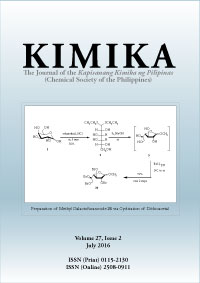Mini Review: Oxazolidinone and Other Sialic Acid C5 Modifications Over the Past Decade
DOI:
https://doi.org/10.26534/kimika.v27i2.1-13Keywords:
sialic acid, C5 modification, oxazolidinone, α-sialylationAbstract
The potential of sialic acids as therapeutic agents has gradually been recognized due to its importance in the proper functioning of living systems, and likewise the virulence of several pathogens. However, synthesis of these compounds often result in poor yields and selectivities because of inherent characteristics associated with their structures. Use of various promoters, solvent systems and introduction of auxiliaries has since improved the outlook of chemical sialylation. Of these, attachment of various groups on C5 has notably resulted in improved α-selectivity. This mini review focuses on C5 structural modification of sialic acids over the past decade, most notably the oxazolidinone group protection.Downloads
Published
2016-10-26
How to Cite
Salmasan, R. (2016). Mini Review: Oxazolidinone and Other Sialic Acid C5 Modifications Over the Past Decade. KIMIKA, 27(2), 1–13. https://doi.org/10.26534/kimika.v27i2.1-13
Issue
Section
Review Articles
License
Authors who publish with this journal agree to the following terms:
- Authors retain copyright and grant the journal right of first publication with the work simultaneously licensed under a Creative Commons Attribution License that allows others to share the work with an acknowledgement of the work's authorship and initial publication in this journal.
- Authors are able to enter into separate, additional contractual arrangements for the non-exclusive distribution of the journal's published version of the work (e.g., post it to an institutional repository or publish it in a book), with an acknowledgement of its initial publication in this journal.
- Authors are permitted and encouraged to post their work online (e.g., in institutional repositories or on their website) prior to and during the submission process, as it can lead to productive exchanges, as well as earlier and greater citation of published work (See The Effect of Open Access).





